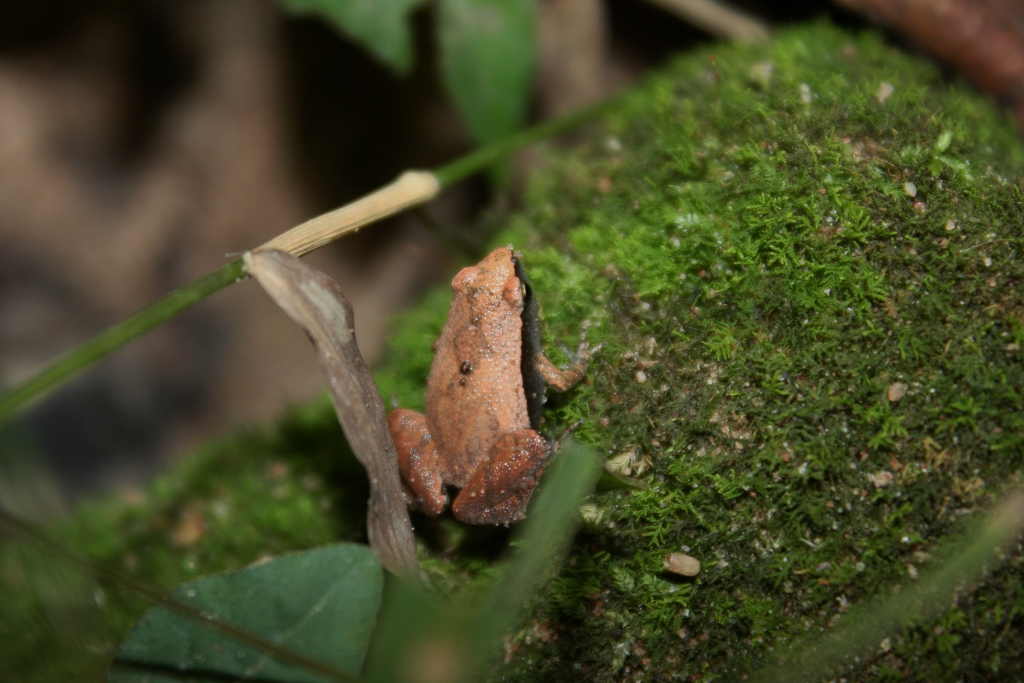You’ve definitely seen or heard frogs around your neighbourhood, especially after a rainy spell. Some of you may even have dissected a few in school labs. Perhaps the most well-known type of frog many of us are familiar with is the American Bullfrog – not because it’s a common native species, but because it’s the species commonly served in porridges! The bullfrog is about the size of a palm and can get to a hefty 1.5kg, but have you seen frogs a lot smaller in size? We’re talking teeny tiny mini frogs that can literally fit on your fingernail.
Remember when someone in Singapore recently stumbled upon a miniscule frog along Orchard Boulevard?

While there was no positive ID on that frog, it may have been the invasive Greenhouse Frog, according to someone in the Singapore Wildlife Sightings group. These amphibians range from 5mm-200mm from juvenile to adult.
A whole new mini world
However, there’s a whole world of miniature frogs out there, and most of them are the same size or even smaller. Back in 2019, evolutionary biologist Mark Scherz and a team of scientists discovered a whole new species of miniature frogs in Madagascar that are the smallest of their kind in the world, and their genus name reflects their stature: Mini.
There are three species under the Mini genus, and so the scientists named them Mini mum, Mini scule, and Mini ature. Very appropriate.
According to Scherz’s blog, the Mini scule – which only gets as large as 10.8mm – is within the top 20 smallest frogs. Adults are between the length of “a tic-tac and a staple.”
Of course, these aren’t the only tiny frogs in the world. Seven new species of miniaturised frogs (the genus Brachycephalus) have been found in the Brazilian Atlantic rainforest back in 2015. The frogs are sometimes labelled “pumpkin toads” due to the often bright orange skin of some members.

In 2017, the smallest frog in the world – the Paedophryne amauensis was discovered in Papua New Guinea, which measures 7mm long.
Miniaturised frogs are found in wet tropical regions, primarily in forests, living near the ground in the moist leaf litter. Interestingly, many species aren’t dependent on water for reproduction – some entirely lack the larval tadpole stage. Instead, females produce a small number of large eggs that develop directly into small froglets!
Since they’re so tiny, they have to adapt with their small bodies. One miniature frog – the Gardiner’s Seychelles frog – is the first land-living vertebrate known to use its mouth for hearing as it lacks ears. It’s a form of adaptation scientists refer to as exaptation. (Other bizarre examples include the giant California sea cucumber which can eat through its anus, and the Chinese soft-shelled turtle which regularly urinates via its mouth.)
Smallest frogs in Singapore
Singapore has its fair share of frogs – about 30 species. If you’re out and about you may notice a few common species hopping about. Most of them are in the 5cm-8cm range, and these include the Green Paddy Frog, Field Frog, Crab-eating Frog, and the Four-Lined Tree Frog, the eggs of which are nestled within foams on plants or rocks.

One of the smallest frogs is the Dark-Sided Chorus Frog, which measures 2.5cm, and produces an extremely loud kriiiiiiik sound. Another small-ish frog is the orange-coloured Cinnamon Bush Frog (4cm), which is a rare species. The males make soft pooop sounds.

On the larger frogs spectrum
If you’ve had enough of small frogs, how about some giant ones? There are much bigger frogs than the American Bullfrog.
The aptly-named Goliath Frog is a monster of a frog which can grow up to 32cm and weigh up to 3.25kg! (For comparison, a heavy Chihuahua dog is only 2.7kg!). These giant amphibians are found near fast-flowing rivers in Middle African countries like Cameroon and Equatorial Guinea and have unique nesting habits: some dig depressions into the riverbanks and encircle them with large rocks, effectively creating their own ponds! Some of the rocks are more than half the frogs’ weight!

The largest species of frog in Asia is the Blyth’s River Frog, which can grow up to 26cm and weigh around 1kg. Also known as the Giant Asian River Frog, it’s usually brown, yellow, or grey, and can be found around rocky streams in the forest regions.

Singapore may be a tiny nation, but even so, our green spaces can really surprise you. Next time you’re out and about, pay attention to the ground – you’ll never know when you’ll stumble upon a rare mini frog.











